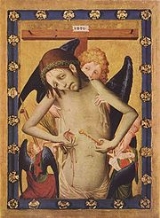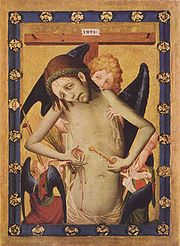
Man of Sorrows
Encyclopedia

Hebrew Bible
The Hebrew Bible is a term used by biblical scholars outside of Judaism to refer to the Tanakh , a canonical collection of Jewish texts, and the common textual antecedent of the several canonical editions of the Christian Old Testament...
that have been identified by Christians as prefigurations of the Messiah
Messiah
A messiah is a redeemer figure expected or foretold in one form or another by a religion. Slightly more widely, a messiah is any redeemer figure. Messianic beliefs or theories generally relate to eschatological improvement of the state of humanity or the world, in other words the World to...
, the Man of Sorrows of Isaiah 53
Isaiah 53
Isaiah 53, taken from the Book of Isaiah, is the last of the four Songs of the Suffering Servant, and tells the story of the Man of Sorrows or "The Suffering Servant", which became a common theme in medieval and later Christian art. The passage is known for its interpretation by many Christians to...
is paramount - the various theological traditions are discussed at that article. The phrase translated into English as "Man of Sorrows" ("vir dolorum" in the Vulgate
Vulgate
The Vulgate is a late 4th-century Latin translation of the Bible. It was largely the work of St. Jerome, who was commissioned by Pope Damasus I in 382 to make a revision of the old Latin translations...
, in German Schmerzensmann) occurs at verse 3:
3) He is despised and rejected of men, a Man of sorrows, and acquainted with grief. And we hid as it were our faces from Him; He was despised, and we esteemed Him not.
4) Surely He hath borne our griefs and carried our sorrows; yet we did esteem Him stricken, smitten of God, and afflicted.
5) But He was wounded for our transgressions; He was bruised for our iniquities. The chastisement of our peace was upon Him, and with His stripes we are healed.
6) All we like sheep have gone astray; we have turned every one to his own way; and the Lord hath laid on Him the iniquity of us all.
The iconic devotional image called the "Man of Sorrows" shows Christ, usually naked above the waist, with the wounds of his Passion prominently displayed on his hands and side, often crowned with the Crown of Thorns
Crown of Thorns
In Christianity, the Crown of Thorns, one of the instruments of the Passion, was woven of thorn branches and placed on Jesus Christ before his crucifixion...
and sometimes attended by angels. It developed in Europe from the 13th century, and was especially popular in Northern Europe. The image continued to spread and develop iconographical complexity until well after the Renaissance, but the Man of Sorrows in its many artistic forms is the most precise visual expression of the piety of the later Middle Ages, which took its character from mystical contemplation rather than from theological speculation". Together with the Pietà
Pietà
The Pietà is a subject in Christian art depicting the Virgin Mary cradling the dead body of Jesus, most often found in sculpture. As such, it is a particular form of the Lamentation of Christ, a scene from the Passion of Christ found in cycles of the Life of Christ...
, it was the most popular of the Andachtsbilder
Andachtsbilder
Andachtsbilder is a German term often used in English in art history for Christian devotional images designed as aids for prayer or contemplation...
-type images of the period - devotional images detached from the narrative of Christ's Passion.
Development of the image

Epitaphios (liturgical)
The Epitaphios is an icon, today most often found as a large cloth, embroidered and often richly adorned, which is used during the services of Great Friday and Great Saturday in the Eastern Orthodox Churches and those Eastern Catholic Churches which follow...
image, which possibly dates back to the 8th century. A miraculous Byzantine mosaic
Mosaic
Mosaic is the art of creating images with an assemblage of small pieces of colored glass, stone, or other materials. It may be a technique of decorative art, an aspect of interior decoration, or of cultural and spiritual significance as in a cathedral...
icon
Icon
An icon is a religious work of art, most commonly a painting, from Eastern Christianity and in certain Eastern Catholic churches...
of it is known as the Imago Pietatis or Christ of Pity. The work appears to have been brought to the major pilgrimage church of Santa Croce in Gerusalemme
Santa Croce in Gerusalemme
The Basilica of the Holy Cross in Jerusalem is a Roman Catholic parish church and minor basilica in Rome, Italy. It is one of the Seven Pilgrim Churches of Rome....
in Rome in the 12th century. Only replicas of the original work now survive. By the 13th century it was becoming common in the West as a devotional image for contemplation, in sculpture, painting and manuscripts. It continued to grow in popularity, helped by the Jubilee Year
Jubilee (Christian)
The concept of the Jubilee is a special year of remission of sins and universal pardon. In the Biblical Book of Leviticus, a Jubilee year is mentioned to occur every fifty years, in which slaves and prisoners would be freed, debts would be forgiven and the mercies of God would be particularly...
of 1350, when the Roman image seems to have had, perhaps initially only for the Jubilee, a Papal indulgence
Indulgence
In Catholic theology, an indulgence is the full or partial remission of temporal punishment due for sins which have already been forgiven. The indulgence is granted by the Catholic Church after the sinner has confessed and received absolution...
of 14,000 years granted for prayers said in its presence.
The image formed part of the subject of the Mass of Saint Gregory
Mass of Saint Gregory
The Mass of Saint Gregory is a subject in Roman Catholic art which first appears in the late Middle Ages and was still found in the Counter-Reformation. Pope Gregory I The Mass of Saint Gregory is a subject in Roman Catholic art which first appears in the late Middle Ages and was still found in...
; by 1350 the Roman icon was being claimed as a contemporary representation of the vision. In this image the figure of Christ was typical of the Byzantine forerunners of the Man of Sorrows, at half length, with crossed hands and head slumped sideways to the viewer's left.
The various versions of the Man of Sorrows image all show a Christ with the wounds of the Crucifixion
Crucifixion of Jesus
The crucifixion of Jesus and his ensuing death is an event that occurred during the 1st century AD. Jesus, who Christians believe is the Son of God as well as the Messiah, was arrested, tried, and sentenced by Pontius Pilate to be scourged, and finally executed on a cross...
, including the spear-wound. Especially in Germany, Christ's eyes are usually open and look out at the viewer; in Italy the closed eyes of the Byzantine epitaphios image, originally intended to show a dead Christ, remained for longer. For some the image represented the two natures of Christ - he was dead as a man, but alive as God. Full-length figures also first appear in southern Germany in wall-paintings in the 13th century, and in sculpture from the beginning of the 14th. Other elements that were sometimes included, in distinct sub-forms of the image, included the Arma Christi
Arma Christi
Arma Christi , or the Instruments of the Passion, are the objects associated with Jesus' Passion in Christian symbolism and art....
or "Instruments of the Passion", the cross, a chalice
Chalice (cup)
A chalice is a goblet or footed cup intended to hold a drink. In general religious terms, it is intended for drinking during a ceremony.-Christian:...
into which blood poured from Christ's side or other wounds (giving an emphasis on the Eucharist
Eucharist
The Eucharist , also called Holy Communion, the Sacrament of the Altar, the Blessed Sacrament, the Lord's Supper, and other names, is a Christian sacrament or ordinance...
), angels to hold these objects or support a slumped Christ himself (Meister Francke shows both roles above), and mourners or worshippers. The Throne of Mercy is an image of the Trinity
Trinity
The Christian doctrine of the Trinity defines God as three divine persons : the Father, the Son , and the Holy Spirit. The three persons are distinct yet coexist in unity, and are co-equal, co-eternal and consubstantial . Put another way, the three persons of the Trinity are of one being...
with Christ, often diminutive, as Man of Sorrows, supported by his Father.
Isaiah 53:2 had already been crucial in developing the iconography of the Tree of Jesse
Tree of Jesse
The Tree of Jesse is a depiction in art of the Ancestors of Christ, shown in a tree which rises from Jesse of Bethlehem, the father of King David; the original use of the family tree as a schematic representation of a genealogy...
("For He shall grow up before Him as a tender plant, and as a root out of a dry ground") and the depiction of Jesus ("He hath no form nor comeliness, and when we shall see Him, there is no beauty that we should desire Him").
See also
- Man of Sorrows (Maarten van Heemskerck)Man of Sorrows (Maarten van Heemskerck)The Dutch painter Maarten van Heemskerck painted the subject of the Man of Sorrows three times. The subject depicts Christ after the crucifixion attended by angels, with wounds prominently displayed, wearing the crown of thorns and a loincloth. The loincloth is claimed to be wrapped around an...
- Messiah (Handel)Messiah (Handel)Messiah is an English-language oratorio composed in 1741 by George Frideric Handel, with a scriptural text compiled by Charles Jennens from the King James Bible and the Book of Common Prayer. It was first performed in Dublin on 13 April 1742, and received its London premiere nearly a year later...
, which sets a version of the passage from Isaiah

